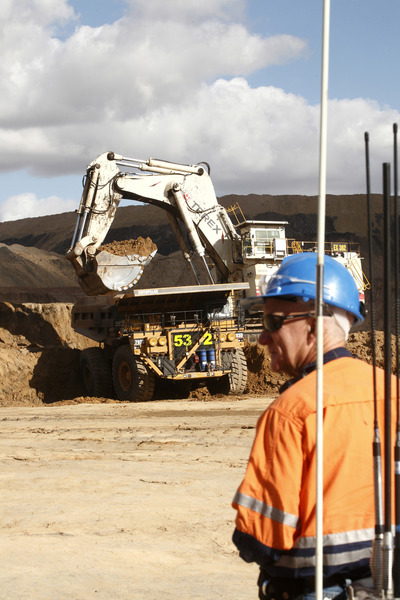Setting the tone
When Anglo American’s Capcoal operation wanted to upgrade to a P25 system, the transmission of vital emergency tones had to be addressed.
When it comes to keeping workforces safe, mining operations really put the ‘critical’ in ‘critical communications’. Whether above ground or below, large or small, mines are full of hazards and risks that have to be managed, and reliable communications are a major part of the solution.
And one of the most important aspects of communications on mine sites is the transmission of blast and emergency tones, to let workers know that explosives are about to be used or that an emergency exists.
When Capcoal - an operation with both underground and open cut mines located in Queensland’s Bowen Basin - wanted to upgrade its radio systems to P25 standard, they had to address the issue of blast and emergency tones.

Omnitronics and Nixon Communications (the latter has handled Capcoal’s communications needs for 30 years and installed the company’s P25 system) worked together to implement a solution as part of the mining company’s new digital radio and dispatch system.
“Previously at the mine, they had blast and emergency tones going over their analog system,” said Gary Davis of Nixon Communications. “So the new P25 system had to have it - there was no question about it. If we couldn’t do the tones, they didn’t want the new radio system. They couldn’t go backwards in terms of the tones.”
The system
“The system supplied was an Omnitronics DX-Altus Digital Radio Management System comprising a modular server, DRG100 digital radio gateways loaded with P25 firmware and Alto dispatch software,” said John Florenca, Omnitronics’ CEO. “The DX-Altus is the hub of the network, while Alto connects operators via the DX-Altus server to control the radio functions, both voice and data.”
The DRG100 gateways connect the server to the radios. These gateways can be configured to convert an ever-growing list of digital radio protocols into one common protocol, without the loss of the functionality of the radios, creating interoperability across protocols.

“This flexible system architecture, along with Omnitronics’ commitment to providing fit-for-purpose solutions, enables companies like Anglo American to install systems that meet their unique needs.”
Installation of the DX-Altus was straightforward. Most of the configuration was done within the DX-Altus’s central configuration screen, which is accessed through a web browser and also provides access to the gateways.
The challenge
“Because of the new technology, putting tones over two-way radios in the new technology was always difficult - it’s not as easy as it was with the analog systems,” said Davis. “With a bit of engineering from us and giving them the input on what we needed, Omnitronics’ engineers were able to get the blast and emergency tones generated over the new digital systems.”
The P25 standard uses the IMBE (Improved Multi-Band Excitation) Codec, which provides good voice quality with low bandwidth but will not transmit pure tones such DTMF, CTCSS, Selcall and warning tones. To provide sine wave alarm sounds, a different mechanism is needed. Some manufacturers’ radios (such as Tait) provide special support for tones, so Omnitronics was able to implement a special mode in the DX-Altus server and the DRG100s to use this feature.

Although not all tone frequencies could be reproduced, reasonable approximations of alarms sounds were created to provide alarm functions. The tones were customised to suit Capcoal’s required tones by changing frequencies, timings, repetition and volumes as well as sending status messages.
“Because everything’s digital you have to transfer the audio into a digital stream, and when it gets to the other end you have to pull it out of the digital stream and modulate it into the transmitters,” said Davis. “So it’s when you transpose these audio tones into digital is where it distorts them. Omnitronics worked out a way to solve this, and they sound like the real thing.
“We were the first company in Australia able to generate these blast and emergency tones over P25.”
Doing the work
“At the German Creek mine, which is part of the wider Capcoal operation, they didn’t have a console,” said Davis. “But in the new requirements that they wanted, they had to have a console. So we put in the new P25 system, and on top of that a console.
“We got the order in late 2012,” added Davis. “The P25 system incorporates six repeaters spread across the mine site. The first one went in in April 2013 and the last one went in in August. And they’re all microwave linked together.”

The DX-Altus system can be expanded in a number of ways: modular architecture means the number of operator positions and the number of radios can be increased; additional sites, such as repeaters and even remote dispatch centres, can be added; and it has multisystem login capability, which means that there can be independent multiple servers that operators can log into as required.
Both the DX-Altus and its predecessor the DX-64 are used in a number of mining applications across Australia, as well as in oil and gas, public safety, ports and other sectors.
“The DRG100 P25 DFSI interface has now been successfully tested with three different radios including the Tait TB9100, Spectra MX800 and RF Technology Eclipse 2,” said Florenca. “These tests have shown the capability of the DRG100 to transmit voice and data back to Omnitronics’ DX-Altus and RediTALK dispatch solutions. This not only enables greater dispatch capabilities but also interoperability across protocols including the capability for phased migration from analog to P25.”
5G drones deliver live images from emergencies
Timely images allow emergency responders to gain an early impression of the situation and provide...
NZ emergency services approach cyclone season with better comms
Emergency services will face this cyclone season with improved cellular communications...
Triple Zero Custodian Bill passes, as Senate inquiry looms
With an open inquiry into Optus and the Triple Zero ecosystem just days away, new legislation has...



